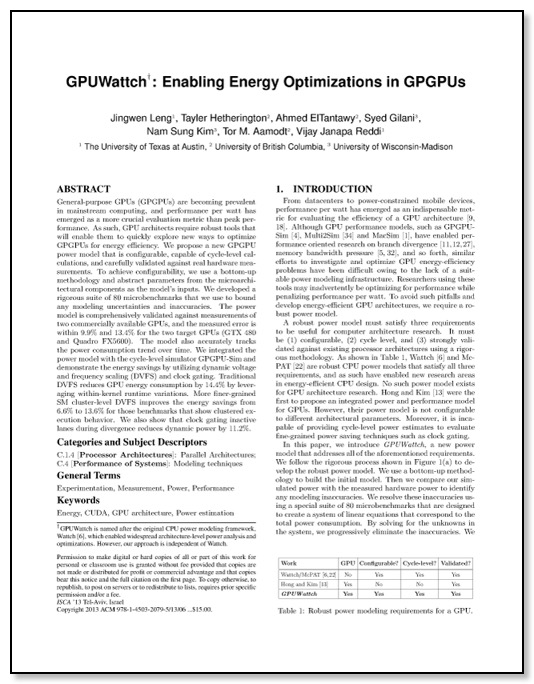Jingwen Leng, Tayler Hetherington, Ahmed El-Shafiey, Syed Gilani, Nam Sung Kim, Tor M. Aamodt, Vijay Janapa Reddi
In Proc. of International Symposium on Computer Architecture, June 2013.
ABSTRACT
General-purpose GPUs (GPGPUs) are becoming prevalent in mainstream computing, and performance per watt has emerged as a more crucial evaluation metric than peak performance. As such, GPU architects require robust tools that will enable them to quickly explore new ways to optimize GPGPUs for energy efficiency. We propose a new GPGPU power model that is configurable, capable of cycle-level calculations, and carefully validated against real hardware measurements. To achieve configurability, we use a bottom-up methodology and abstract parameters from the microarchitectural components as the model’s inputs. We developed a rigorous suite of 80 microbenchmarks that we use to bound any modeling uncertainties and inaccuracies. The power model is comprehensively validated against measurements of two commercially available GPUs, and the measured error is within 9.9% and 13.4% for the two target GPUs (GTX 480 and Quadro FX5600). The model also accurately tracks the power consumption trend over time. We integrated the power model with the cycle-level simulator GPGPU-Sim and demonstrate the energy savings by utilizing dynamic voltage and frequency scaling (DVFS) and clock gating. Traditional DVFS reduces GPU energy consumption by 14.4% by leveraging within-kernel runtime variations. More finer-grained SM cluster-level DVFS improves the energy savings from 6.6% to 13.6% for those benchmarks that show clustered execution behavior. We also show that clock gating inactive lanes during divergence reduces dynamic power by 11.2%.
